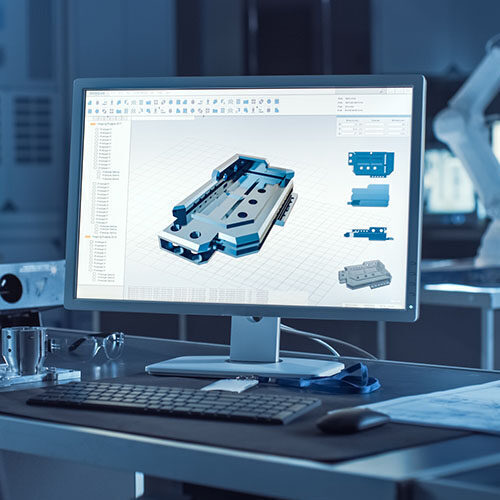
One of the biggest problems I see in the manufacturing industry is AI.
No, not artificial intelligence, but abandoned implementation of ERP systems. One of the biggest changes a manufacturer can make to help streamline and grow their business is getting an ERP system, but all too often manufacturers succumb to AI. In fact, 75% of ERP implementations are deemed failures by Gartner. (Not Genius Solutions though! We have a proven 10-step process that gives us industry-leading implementation success rates.) If you don’t want to be a victim of AI, read on below to get my tips on how to successfully implement an ERP system, and reap the many benefits an ERP system can bring to your business.
Successfully completing an ERP implementation project starts with the sales process.
When you start shopping around and talking to different ERP providers, the sales representatives that you speak with will want to downplay the disruptiveness of an ERP, and only focus on the benefits of the system (of which there are many!), but not some of the challenges a system may bring to your plant. This may be an effective sales technique, as it will get you as a customer excited about the system, and willing to open your checkbook, but it can actually backfire and put you on the path to AI before you have even signed on the dotted line.
I rarely see manufacturers abandon implementing an ERP system because of the technology — there are many excellent ERP providers out there, and it is important for you to find the one that aligns with your businesses goals and needs. But make sure that the ERP partner you choose to deal with doesn’t just sell you on their system’s features, but tells you about the challenges that you will face and the disruption to your business that you will see while implementing an ERP.
I’ll be very honest with you — we have lost deals over this.
When consulting with potential clients we will tell them that implementing an ERP is disruptive and will take time. And sometimes these customers will walk away from us because they tell us a competitor said it would take less time, be less disruptive, and would be an easy process. And you know what, when I reach out to these customers again, they tell me “I should have listened to you, you were right!” The ERP implementation project took much longer and was much more complicated and disruptive than the client thought it would be. And sometimes these customers have fallen into the AI trap and have not implemented their new ERP system at all, and are starting from scratch once again.
When I meet with new potential clients I don’t want to sell them a system too quickly. Though this may seem counterintuitive, and possibly a bad business practice, it actually helps set both us as a provider, and you as a client, up for success. I not only take the time to review the features of our product, how it is built exclusively for SME manufacturers, and the many benefits it can bring to your business. But I also spend time discussing the challenges, the disruption, and the change that will need to be managed and overcome during the implementation process. Being informed upfront will help you as a client to better plan and organize the implementation process and get the right team in place from the very beginning. Be aware that the process will be disruptive, like all major changes, but that if you plan for it from the start it will go easier and you’ll see the benefits of the system quicker.
After you have signed on the dotted line, the initial time period before you actually start implementing the system is crucial.
This is the time to develop a strong relationship between the ERP consultant and your company. It’s our job as the service provider to learn your business inside and out, and to fully take you through the timeline and process, and make you aware of the resources needed to successfully implement the system. But remember this is a two way street and both parties need to disclose information. We need to know the key people within your organization — and the ones that may also be resistant to the system. We also need to know how your business functions and runs now, and what your future goals are, so that we can identify priorities and put the right features in place first. As I said in my previous article it’s important to break down an implementation project into shorter, more achievable phases — not everything can, or should be done in phase one. Planning your implementation in short phases will let you get the most important features up and running quickly, and help your staff manage the change more effectively.
When we start working with a new client we provide them with an implementation success checklist, highlighting the steps that need to be taken to create a successful implementation project. It’s important that both parties are upfront with each other, and spend a good deal of time on knowledge transfer before the project starts. Take time to Identify what are the most important things that need to be implemented. Get the right people on board from the start. Build plenty of time for training, and problem solving into the implementation timeline — you know you will run into snags along the way, so make sure you account for the time needed to sort them out. Know you will be living with some disruption and prepare yourself to be okay with chaos and instability for a short amount of time. Trust in the process and the experience of your consultant.
And my number one piece of advice to avoid AI: planning and perseverance.
Taking the time to plan and prepare from the start will give you a solid foundation for your project, and bring you plenty of success down the line. And having the perseverance and persistence to move forward even when you hit a bump in the road will ensure you keep on going. It took you and your organization a lot of hard work to get where you are going — if you stop before you reach the top of the hill you’ll lose everything you have achieved so far. When you hit the inevitable tough spot, press hard, trust in the planning and preparation you did to get where you are, and don’t stop because the benefits are just on the other side of the hill.
Get your eBook Scared to implement a new ERP?
"*" indicates required fields



